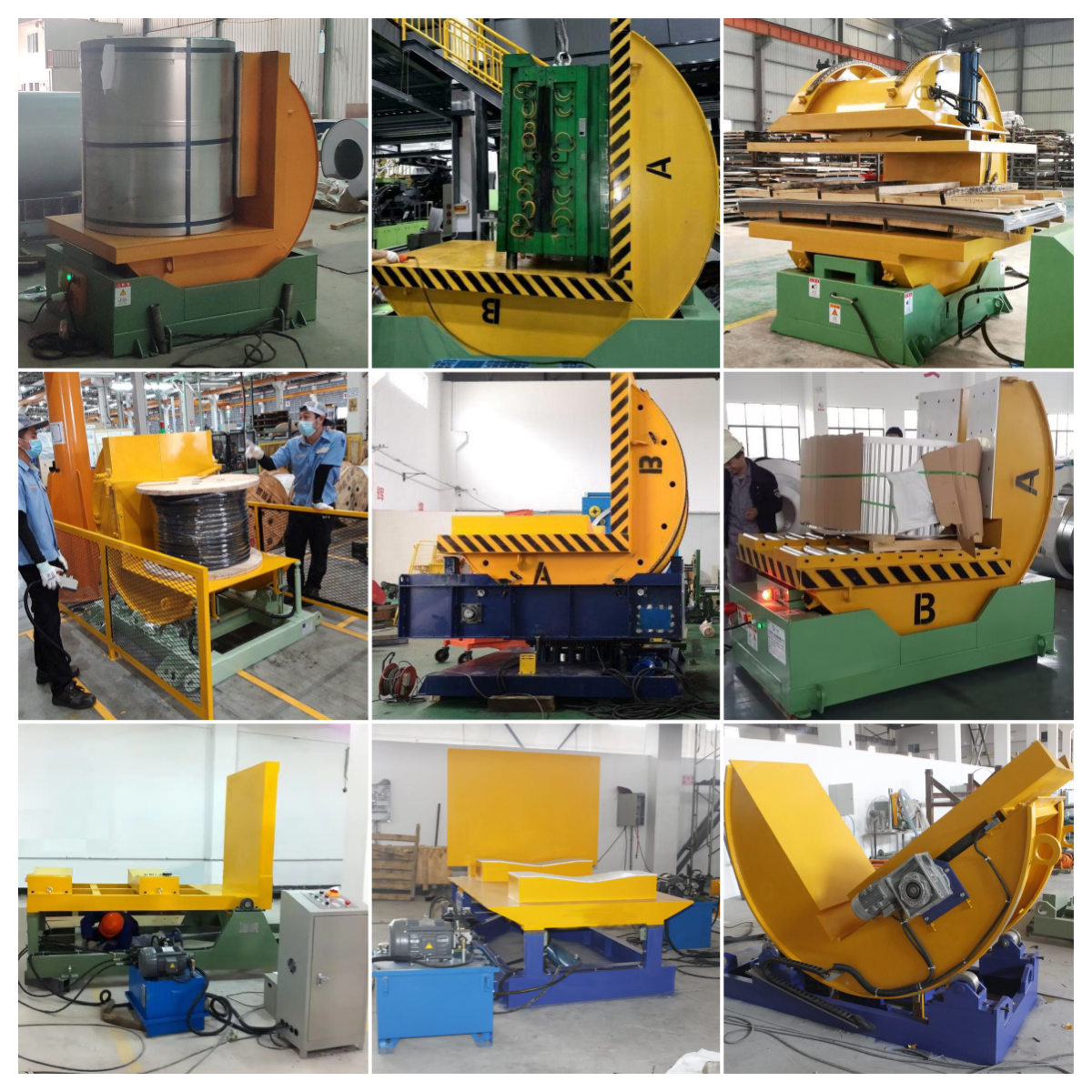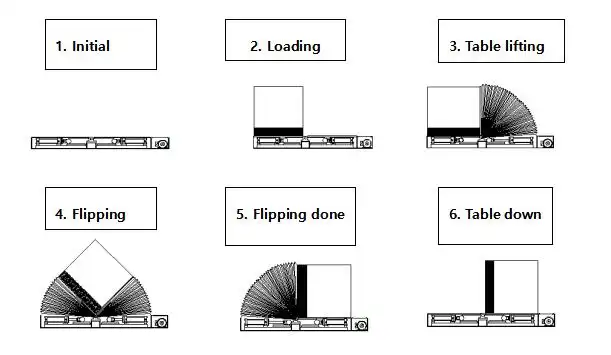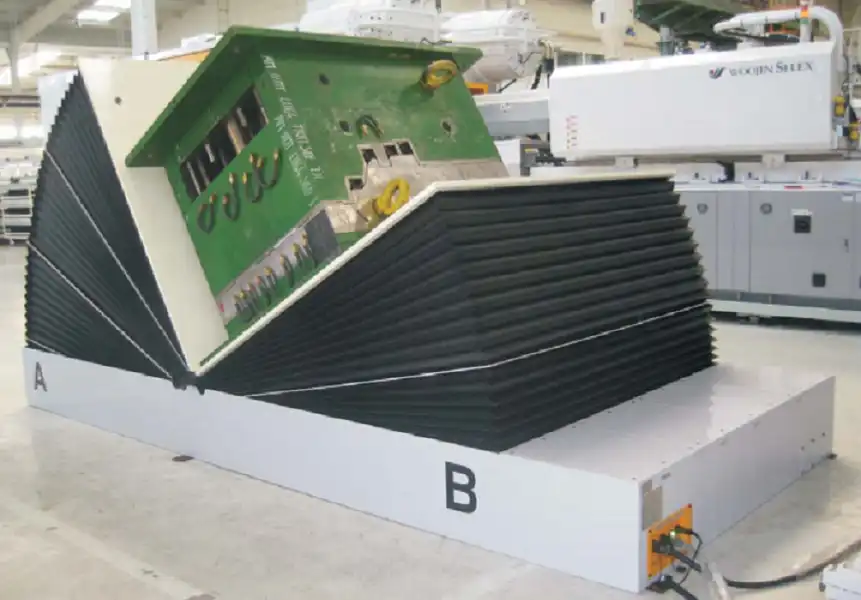How Much Time and Injury Risk Can Canadian Manufacturers Save with a Mold Tilter?
Flipping a multi-ton mold or die with an overhead crane is a tense moment on any factory floor. You see operators carefully rigging chains, communicating with hand signals, and slowly, cautiously maneuvering a massive, expensive piece of equipment. It's a process that eats up time and ties up your crane. But the real problem is the risk. Every one of these manual flips is a gamble, a moment where a single slip or miscalculation could lead to a catastrophic accident, a damaged mold, and a halt in production. This outdated method is a hidden drain on your resources and a constant safety liability. The solution is simpler and more effective than you might think: a dedicated machine built for one purpose—to tilt heavy loads safely and efficiently.
A mold tilter can save Canadian manufacturers hundreds of valuable man-hours annually and reduce the risk of severe crush, pinch, and strain injuries by over 90%. By replacing the slow, multi-person crane-and-chain method with a fast, one-operator push-button solution, factories can reclaim an average of 30 to 60 minutes per flip. This translates directly into significant operational savings through reduced labor costs, lower insurance premiums, minimized production downtime, and the prevention of costly accidents and equipment damage.

The numbers are compelling, but they only tell part of the story. The real value of a mold tilter extends far beyond a simple calculation of time saved. It's about transforming a high-risk, unpredictable task into a standardized, safe, and efficient part of your workflow. It's about freeing up your most valuable assets—your skilled people and your critical equipment—to focus on what they do best: producing quality parts. Let’s dive deeper into exactly how these savings are realized and what it means for the overall health of your operation.
How Does a Mold Tilter Directly Reduce Handling Time?
Your team of skilled toolmakers and machine operators are your most valuable asset. Yet, how much of their time is spent on a non-value-added task like flipping a mold? They stop their primary work, call for a crane, find the right chains and rigging, and then spend the next half hour or more carefully maneuvering a heavy load. This process is a major bottleneck. Every minute they spend on this cumbersome task is a minute they are not maintaining another tool, setting up a machine, or contributing to production. A specialized mold tilter changes this dynamic completely, turning a lengthy, multi-person job into a quick, one-person task that takes just a few minutes.
A mold tilter can slash the time needed to flip a heavy mold from 30-60 minutes down to less than 5 minutes. This dramatic time reduction comes from eliminating the need for complex crane rigging, multiple operators, and the slow, cautious pace required for manual lifting. With a tilter, an operator simply places the mold on the machine, pushes a button, and watches as it safely rotates to the desired angle in a controlled, predictable motion.

The Manual Process vs. The Automated Process
Let's break down the difference. When I started as an engineer on the factory floor, I saw the manual process firsthand, day in and day out. It was a production ritual, but a slow and inefficient one. An operator would need to find a certified rigger, wait for the overhead crane to be free, and then slowly begin the process. Contrast that with the automated process I later implemented in my own factory and for clients like Javier. The change is like night and day.
Here is a clear comparison:
| Feature | Manual Tilting (Crane & Chains) | Automated Tilting (Mold Tilter) |
|---|---|---|
| Personnel Required | 2-3 (Crane operator, Rigger, Spotter) | 1 (Machine Operator) |
| Typical Time | 30 - 60+ minutes | 2 - 5 minutes |
| Equipment Used | Overhead Crane, Chains, Slings | Mold Tilter |
| Key Steps | Wait for crane, Rig chains, Lift, Slow turn, Lower, Un-rig | Load mold with forklift, Press button |
| Risk Factor | High (Dropping, Swinging, Pinch points) | Very Low (Controlled, stable motion) |
Eliminating Production Bottlenecks
The most significant time saving isn't just the 30 minutes you get back from the flipping process itself. It's the elimination of the bottleneck. In many Canadian plants, especially in the tool and die, injection molding, and stamping sectors, the overhead crane is the hardest working piece of equipment. It moves raw materials, loads machines, and transports finished goods. When it's tied up for 45 minutes flipping a mold, other critical operations stop. Production stalls. People wait. A mold tilter, typically situated in a dedicated die maintenance area, operates independently. It frees up your crane to perform its primary, value-adding tasks, smoothing out the entire production flow.
Quantifying the Time Savings
Let's do some simple math that a practical owner like Javier would appreciate. Assume your plant flips two molds per day for maintenance.
- Time saved per flip: 30 minutes (a conservative estimate)
- Total time saved per day: 30 minutes/flip * 2 flips/day = 60 minutes
- Workdays per year: ~250
- Total hours saved per year: 1 hour/day * 250 days = 250 hours
That's 250 hours of skilled labor and crane time that you can now allocate to productive activities. It's not just a number; it's a significant increase in your plant's effective capacity without adding a single new employee.
What Are the Hidden Costs of Manual Mold Tilting?
When you look at the cost of flipping a mold, you probably see the wages of the two or three employees involved for that half hour. That’s the obvious cost. But the real financial danger lies in the costs you don't see on a daily basis. I’m talking about the slow, cumulative damage to your expensive molds, the high insurance premiums you pay for high-risk activities, and the ever-present threat of a life-altering accident. These hidden costs can be far more damaging to your bottom line than any direct labor expense. By continuing to use outdated methods, you are accepting a level of financial and operational risk that a dedicated machine can almost completely eliminate.
The hidden costs of manual mold tilting are substantial. They include the potential for scratches, dents, and misalignment from chains and improper handling, leading to expensive repairs and quality issues. They also include higher Workers' Compensation premiums in Canada due to the high-risk classification of the task, production delays caused by crane conflicts, and the devastating financial and human cost of a serious or fatal accident.

The High Cost of an Accident
This is the cost that no one wants to think about, but every plant owner must. Early in my career, I saw a near-miss that I'll never forget. A heavy die slipped in its chains while being turned. It only dropped a few inches, but the sound of the metal and the look on the operators' faces was terrifying. It could have easily crushed a limb or worse. The cost of such an incident goes far beyond immediate medical care. In Canada, a serious workplace injury involves WCB claims, lost workdays for the injured employee, investigation time, potential fines from provincial safety authorities, and legal fees. The indirect costs, like the drop in team morale and the production shutdown during the investigation, can be even greater. A mold tilter is an engineering control that removes the human from the most dangerous part of the process, making it a powerful form of accident insurance.
Protecting Your Investment
Your molds and dies are precision instruments, and they are incredibly expensive. A single large injection mold or stamping die can be worth hundreds of thousands of dollars. Every time you wrap it in chains and lift it with a crane, you risk damaging its critical surfaces. A scratch on a parting line or a dent on a core can lead to flawed parts, requiring hours of expensive, skilled polishing and repair. Or worse, the mold might need to be sent out for welding and re-machining, causing significant downtime. A mold tilter supports the entire weight of the mold on a stable platform, rotating it smoothly without any chains or slings ever touching the precision surfaces. It protects your investment every single time.
The Insurance and Compliance Factor
Insurance companies and provincial safety bodies like Ontario's WSIB or WorkSafeBC in British Columbia are not blind to risk. They know that tasks like manually flipping heavy, irregular loads are high-risk. Your insurance premiums reflect this. By proactively installing an engineered safety solution like a mold tilter, you are demonstrating a commitment to risk reduction. This can be a powerful point of discussion with your insurer to lower premiums. Furthermore, it ensures you are in compliance with the general duty clause of Canadian OH&S regulations, which requires employers to take every reasonable precaution to protect workers.
| Hidden Cost Category | Example Costs |
|---|---|
| Accident-Related | WCB Premiums, Medical Bills, Lost Time, Investigation Costs, Legal Fees |
| Equipment Damage | Mold/Die Repair, Part Quality Issues, Production Downtime |
| Operational | Crane Downtime, Waiting Time for other departments, Production Delays |
| Compliance | Potential Fines, Stop-Work Orders, Increased Scrutiny |
How Does a Mold Tilter Improve Overall Plant Efficiency and Safety in Canada?
You are constantly looking for ways to improve your plant's overall efficiency. You analyze cycle times, streamline workflows, and invest in better machines. But often, the biggest gains come from fixing the small, nagging problems that disrupt the flow of work. The process of flipping a mold is one of those problems. It seems like a minor task, but it has a ripple effect, tying up your most critical piece of material handling equipment—the overhead crane—and creating a safety hazard. By isolating this task with a dedicated mold tilter, you not only solve the immediate problem but also unlock new levels of efficiency and safety across the entire facility.
A mold tilter improves overall plant efficiency by freeing up the overhead crane to perform its primary functions, which reduces production bottlenecks and enables a smoother, more predictable workflow. At the same time, it dramatically enhances safety by creating a standardized, engineered, and controlled process for what is otherwise a high-risk manual task. This proactive approach to safety aligns perfectly with the stringent OH&S standards expected of Canadian manufacturers.

The Crane: Your Most Over-Utilized Asset?
Think about your overhead crane. It is the backbone of your plant's material handling. It's needed to unload steel coils from trucks, move dies to the press, transport finished goods to the shipping area, and clear scrap bins. It is almost always in demand. When your die maintenance team needs the crane to flip a mold, they effectively put in a request and wait. That waiting time is waste. And while they are using it for 30-45 minutes, another department is waiting for it. I have seen production lines sit idle, waiting for the crane to become available. A mold tilter acts as a dedicated work cell, taking this specific, time-consuming task completely off the crane's schedule. This simple change can have a massive positive impact on your plant's capacity utilization, a key goal for any manager like Javier.
Creating a Leaner, Safer Workflow
Lean manufacturing principles are all about eliminating waste. The traditional method of flipping a mold is filled with waste: waiting (for the crane), excess motion (rigging and positioning), and defects (potential damage to the mold). A mold tilter supports a lean workflow by creating a standardized process. The mold comes to a specific maintenance area, it is loaded onto the tilter, serviced, and then moved to its next station. The process is the same every time. It's fast, predictable, and safe. This predictability allows for better scheduling and planning, which is the foundation of an efficient operation.
A Culture of Safety and Continuous Improvement
Investing in equipment like a mold tilter sends a powerful message to your employees. It tells them that you value their safety not just with words, but with action and capital investment. When workers feel safe and valued, morale improves, and they become more engaged in their work. This is the foundation of a strong safety culture. In my experience, plants that invest in making processes safer are also the ones that are most open to other ideas for continuous improvement. Providing your team with the right tools, like a mold tilter, empowers them to do their job better and more safely, fostering an environment where everyone is looking for ways to improve. This cultural shift is an intangible benefit, but its impact on productivity and employee retention is very real.
What is the ROI of a Mold Tilter for a Typical Canadian Manufacturing Plant?
As a business owner, every investment decision comes down to the numbers. A new piece of equipment must pay for itself. You need to see a clear path to a return on your investment (ROI). Looking at the price tag of a mold tilter is only the first step. The real analysis comes when you weigh that initial cost against the daily, weekly, and annual savings it will generate. When you factor in the saved labor, the elimination of downtime, the prevention of costly accidents, and the protection of your valuable molds, the financial case becomes incredibly strong. The question isn't whether you can afford a mold tilter; it's whether you can afford to continue without one.
For many Canadian manufacturing plants, the return on investment (ROI) for a mold tilter is typically realized within 12 to 24 months. This rapid payback is calculated by comparing the upfront equipment cost to the combined annual savings from multiple areas: drastically reduced labor hours for mold handling, eliminated production downtime from crane unavailability, potential reductions in insurance premiums, and the prevention of even a single costly incident involving employee injury or mold damage.

Calculating Your Tangible Savings
The best way to see the ROI is to put your own numbers into a simple calculation. I’ve worked with many clients, pragmatic leaders like Javier, to walk through this exact exercise. It brings clarity to the decision-making process.
Let’s build a conservative ROI scenario for a typical Canadian plant:
| Cost/Saving Category | Assumption | Annual Financial Impact |
|---|---|---|
| Labor Savings | 250 hours/year saved @ $40/hr (loaded rate) | $10,000 |
| Crane Uptime Value | 250 hours/year @ $60/hr (operational value) | $15,000 |
| Prevented Mold Damage | Averting one minor repair per year | $5,000 |
| Accident Prevention | Averting one minor WCB claim every 3 years | $10,000 / 3 = ~$3,333 |
| Total Annual Savings | $33,333 |
If a suitable mold tilter costs, for example, $40,000, your payback period is just over 14 months ($40,000 / $33,333). After that, it generates pure profit for your operation every year. These are conservative numbers; a single serious accident or major mold repair would result in an ROI measured in weeks, not months.
A Story of Success
I remember a client, a tool and die shop owner in Ontario. He was sharp, focused on his numbers, and saw a tilter as a "nice-to-have," not a "need-to-have." He was managing his risks with training and procedures. But after a near-miss incident where a 10-ton die shifted in its rigging, he called me. We sat down and did the math, just like the table above, but with his real-world numbers. He saw the light. A year after installation, he told me it was the single best capital investment he had made in the last five years. His team was happier, his crane was always available for production, and his mold maintenance was faster than ever. That peace of mind and operational efficiency is the real return.
The Intangible ROI
Beyond the hard numbers, there is a significant intangible return. How do you measure the value of improved employee morale? What is the dollar value of your reputation as a safe, modern employer in a competitive Canadian labor market? These factors don't appear on a balance sheet, but they directly impact your ability to attract and retain skilled talent, which is critical for long-term success. A mold tilter is a visible symbol of a forward-thinking company that invests in its people and its processes.
Conclusion
A mold tilter is not an expense; it is a strategic investment in safety, efficiency, and profitability for any Canadian manufacturer that needs to handle heavy tools and dies.





